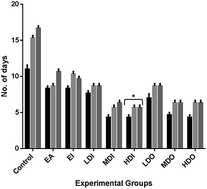Effect of a novel compound as dietary supplement on growth of decapod crustaceans†
Abstract
Several conventional methods have been used for many years to accelerate the growth in decapod crustaceans but they are not suitable for aquaculture practices due to their harmful effects on the animals. Concern over water quality, environmental hazards, human health and food safety has led us to search for alternative targets, to design growth enhancers which can significantly improve the growth of crustaceans without harmful effects. Among such compounds is CGE-1, an amine compound which has shown excellent molt inducing property. Lobsters treated with CGE-1 exhibited a higher weight gain and greater increment in the carapace length post-molt as compared to the controls even without inhibiting the synthesis and secretion of molt-inhibiting hormone (MIH). This is a significant finding considering the fact that MIH binds specifically to the membrane receptor of y-organs, hence CGE-1 might interfere with this interaction allowing an incessant production of 20-hydroxyecdysone (20E). Here, we summarize our findings on CGE-1 and its effects with particular focus on inclusive growth and vitellogenesis. Our observations and findings suggest that CGE-1 could be a useful growth enhancer that could be used either alone or as a dietary supplement for the rapid growth of decapod crustaceans.


 Please wait while we load your content...
Please wait while we load your content...